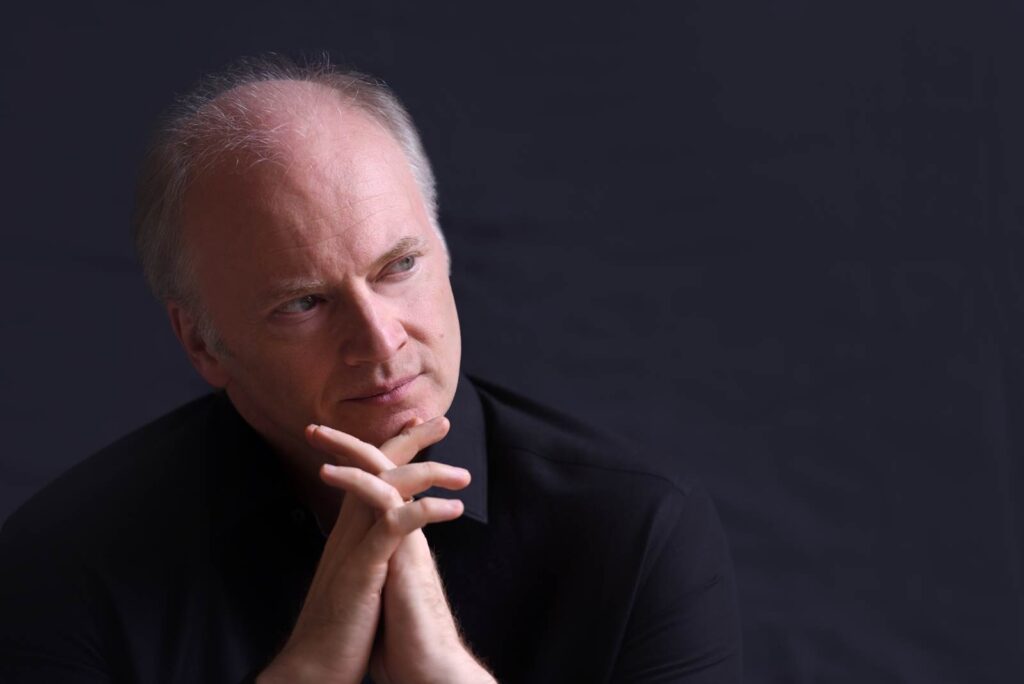Noseda, Hahn, and National Symphony wrap Arsht series on triumphant note

Gianandrea Noseda conducted the National Symphony Orchestra Saturday night at the Arsht Center. Photo: Stefano Pasqualetti
For decades, the National Symphony Orchestra has been an enigma. The Washington DC-based ensemble has had distinguished music directors (including Antal Dorati, Mstislav Rostropovich, Leonard Slatkin and Christoph Eschenbach) but has rarely performed above a level of mediocrity.
That appears to have totally changed. On Saturday night, the orchestra appeared at the Arsht Center under its current chief conductor Gianandrea Noseda and displayed a standard of performance that can rank with the best of American orchestras. (Noseda’s’s NSO contract was renewed last week through 2031.)
Noseda, who is also music director of the Zurich Opera and principal guest conductor of the London Symphony Orchestra, is a vigorous and dynamic presence on the podium. His beat is totally clear and his gestures purposeful to the music’s changing moods and dynamics. He drew consistently brilliantly playing from all sections, encouraging the musicians to really project incisively and with tonal luster.
Noseda’s total command of the ensemble was immediately evident in Carlos Simon’s Four Black American Dances. An unapologetic pops piece, Simon’s appealing concoction is a minefield of changes in meter, dynamics and balances. Strong and vibrant brass captured the bluesy caste of “Ring Shout” with a country fiddle adding a down-home touch. The waltz movement is full- scale Hollywood of the Miklós Rózsa variety. The percussion battery was put through its paces in “Stomp.” A contemporary pop sensibility engulfed “Holy Dance” with Noseda ratcheting up the volume and excitement, with the brass imposing in full cry.
After a seven-month hiatus due to a double-pinched nerve, Hilary Hahn has returned to the concert stage, and her soaring, magnetic traversal of Brahms’ Violin Concerto in D Major proclaimed that she is back in top form.
Since her teens, Hahn has been one of the finest and most compelling violinists on the concert stage. Unlike many players, she does not attempt to dazzle her audience with sheer bravura. To be sure, she possesses a stellar technique yet Hahn’s strength has always been her deeply probing musicianship, an ability to bring out a work’s inner layers.
From her first entrance in the Allegro non troppo, Hahn’s singing tone, and varied dynamic and color palette were most impressive. Maintaining a forward lyrical line, Hahn fully enveloped the heart of Brahms’ mix of passion and virtuosity. Under Hahn’s hands, the extended cadenza was more than an exuberant display. She connected the thematic strands that link the solo moments to the movement’s broader arc.
Taking a spacious tempo in the Adagio, Hahn displayed her strong personality in Brahms’ distinct brand of romanticism. She captured the gypsy spirit of the Allegro giocoso finale while being unafraid to slow the pace for greater emphatic detailing. Throughout the concerto, Hahn’s perfectly calibrated mix of sweetness, elegance and fiery articulation radiated excitement. Noseda’s carefully balanced accompaniment was a model of fine collaboration. The ravishing moments of violin and winds playing in tandem riveted the ear, bringing forth felicities that get obscured in less meticulous performances.
The standing, cheering response to the superb Brahms performance was unusually long and loud. With Noseda taking a seat in the orchestra, Hahn offered Carlos Simon’s Shards of Light as an encore. Written for her, the piece is mostly soft, creating an atmosphere of gentle fragrance and delicacy. Despite its modest aura, much of Simon’s writing is in the instrument’s difficult top reaches. Hahn played the vignette with ravishing tone and total engagement.
Beethoven’s Symphony No. 5 in C minor is probably the most frequently programmed of all symphonies but there was nothing conventional or mundane about the performance by Noseda and the NSO. This was thoroughly modern Beethoven with taut pacing and spare vibrato. The relentless momentum Noseda brought to the iconic first movement Allegro con brio was undeniably exciting, leading one audience member to yell out “Yeah!” at the movement’s conclusion. Noseda drew a lovely, almost vocal line from burnished strings in the Adagio con moto while giving careful attention to Beethoven’s dynamic markings.
The six double basses had a field day in the trio section of the Scherzo, with their invigorating playing. Noseda carefully built the transition to the Allegro finale, the opening ringing out with vigor and affirmation. With the orchestra playing at fever pitch, Noseda turned the final pages into an exhilarating, triumphal anthem and tribute to the human spirit.
An ovation is inevitable after a Beethoven Fifth performance. Noseda responded to it with a sprightly run through Mozart’s Overture to The Marriage of Figaro that captured the bubbly opera buffo spirit of the music, concluding the Arsht Center’s classical series on a bright note.
Daniel Harding conducts the Cleveland Orchestra in Elgar’s Enigma Variations and Sea Pictures with contralto Avery Amereau 8 p.m. May 2 and 3 at the Arsht Center in Miami. arshtcenter.org
Posted in Performances
2 Responses to “Noseda, Hahn, and National Symphony wrap Arsht series on triumphant note”
Leave a Comment
Sun Mar 23, 2025
at 12:21 pm
2 Comments

Posted Mar 23, 2025 at 12:38 pm by joel and Emily Rosenthal
A beautifully nuanced review that is up to and captures the quality of this wonderful performance.
Posted Mar 24, 2025 at 7:29 am by Karl E Thoennes
I agree, excellent review. I’m an ardent traditionalist but even the first piece was both fun and technically so impressive. My teenage boys were literally on the edge of their seats leaning on the box railing enthralled with the performance. Hahn’s encore – what a thrill, the ringing of those single notes was just exquisite, and the Figaro encore – what a treat. And the first obie, just sublime, especially with that delicate lovely Brahms phrase that she hands to the violin.